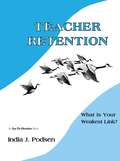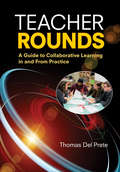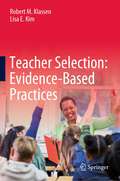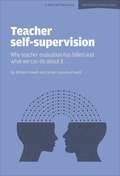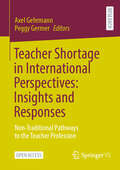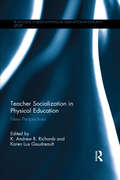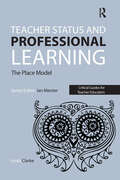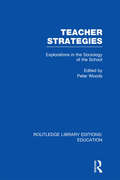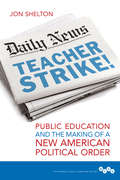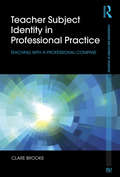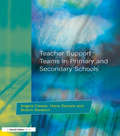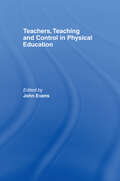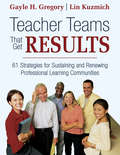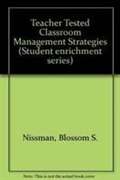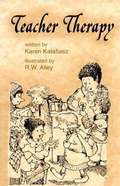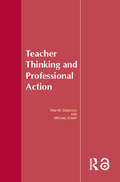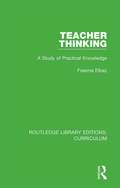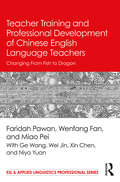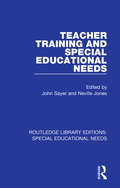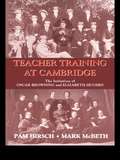- Table View
- List View
Teacher Retention: What is Your Weakest Link?
by India PodsenThis book is for you if you are: challenged by the number of teacher vacancies at the start of your school year, finding that your most promising teachers are resigning before they complete their first few years on the job, or no longer willing to accept that your veteran teachers are just marking time until their retirement. Best-selling author India Podsen shows you how to uncover and analyze retention risks at your school; implement induction programs to help novices master the realities of full-time teaching; engage your experienced teachers in the retention process; and apply the Professional Educator Career Framework, consisting of Four Career Stages: teacher inductee, teacher specialist, teacher leader, and teacher steward. This book provides school leaders with practical suggestions and easy-to-use tools such as checklists and action plans, sample meeting programs and agendas, evaluation templates, benchmarks and standards, and all designed to help you deal successfully with teacher shortages and related problems.
Teacher Rounds: A Guide to Collaborative Learning in and From Practice
by Thomas A. Del PreteTeacher Rounds: Powerful peer-to-peer teacher professional development! Teachers are ready to be in the driver’s seat as leaders of their own learning—and their best professional development resources may be their own classrooms and colleagues. With Teacher Rounds methodology, teachers learn with and from each other through classroom observation and inquiry and develop a trusted community of practice. Scholar-teacher Thomas Del Prete outlines every aspect of this ongoing, collaborative approach: Step-by-step guidance and tools for implementing Teacher Rounds Insights on creating a positive environment for honest feedback A wealth of examples from a high-performing school and across all grade levels and disciplines
Teacher Selection: Evidence-Based Practices
by Robert M. Klassen Lisa E. KimMarketing text: This book combines theory and research from educational and organizational psychology to provide guidance on improving the teacher selection process and, subsequently, educational outcomes for all students. The book identifies the characteristics of effective teachers, analyzes research on selection practices, and examines new approaches to teacher selection, recruitment, and development. The central premise of the book is that improving the effectiveness of teachers – and, thus, students’ educational outcomes – can be achieved by making the recruitment and selection process more effective and more efficient. Accordingly, the book describes how to identify and select individuals for the teaching profession who display both strong cognitive attributes (e.g., subject knowledge) and essential non-cognitive attributes such as resilience, commitment to the profession, and motivation for teaching. Key topics Teacher selection practices from the viewpoint of organizational and educational psychology Teacher effectiveness and the role of individual attributes Situational judgment tests (SJTs) and multiple mini-interviews (MMIs) for teacher selection Implementation of teacher selection programs Teacher recruitment and development Given its scope, the book represents an essential reference guide for scholars, educational leaders and policymakers, and graduate students in educational leadership programs, as well as professionals in child and school psychology, educational psychology, teaching and teacher education.
Teacher Self-Supervision: Why Teacher Evaluation Has Failed and What We Can Do About it
by William PowellMany, perhaps even most schools, are not reaching their potential to be places of collective learning. The authors believe that one of the greatest impediments to realizing this vision is the deleterious effect of traditional systems of teacher evaluation. Rather than infantilizing teachers, we need to empower them. Traditional forms of teacher evaluation have failed. They are riddled with negative expectations about teachers and what motivates them. Taken together, these underlying assumptions form a pernicious cloud of counterproductive expectations that many teachers will "live down to". Inadvertently, the traditional system of teacher evaluation has created a vicious cycle of "self-sealing logic." It is now time for teachers to reclaim their profession, the process of which involves a relentless focus on adult learning: professional learning that is self-directed. The more dynamic and stimulating the culture of adult learning, the more dynamic and stimulating student learning will be.
Teacher Self-Supervision: Why Teacher Evaluation Has Failed and What We Can Do About it
by William PowellMany, perhaps even most schools, are not reaching their potential to be places of collective learning. The authors believe that one of the greatest impediments to realizing this vision is the deleterious effect of traditional systems of teacher evaluation. Rather than infantilizing teachers, we need to empower them. Traditional forms of teacher evaluation have failed. They are riddled with negative expectations about teachers and what motivates them. Taken together, these underlying assumptions form a pernicious cloud of counterproductive expectations that many teachers will "live down to". Inadvertently, the traditional system of teacher evaluation has created a vicious cycle of "self-sealing logic." It is now time for teachers to reclaim their profession, the process of which involves a relentless focus on adult learning: professional learning that is self-directed. The more dynamic and stimulating the culture of adult learning, the more dynamic and stimulating student learning will be.
Teacher Shortage in International Perspectives: Non-Traditional Pathways to the Teacher Profession
by Axel Gehrmann Peggy GermerThis Open Access volume aims to inspire innovative and culturally-responsive transformations in teacher education practices and policies within Europe and beyond in the context of teacher shortage. It amalgamates the collaborative efforts during several years between the Center for Teacher Education and Educational Research (ZLSB) at TU Dresden University of Technology (Saxony, Germany) and eleven international partners. The articles inside explore different viewpoints on teacher shortage and endeavors to systematically navigate the intricacies of the problem in light of contemporary political shifts, institutional paradigms of universities, and the theoretical contemplations of the respective nations. Researchers from Australia, the Czech Republic, Denmark, the United Kingdom, Germany, Ireland, Japan, Poland, Sweden, Switzerland, and the United States venture into new territories by intertwining the discourse about teacher shortage with alternative routes into the teaching vocation.
Teacher Socialization in Physical Education: New Perspectives (Routledge Studies in Physical Education and Youth Sport)
by K. Andrew R. Richards and Karen Lux GaudreaultSocialization is a complex process which has a profound effect on how we experience teaching and learning. The study of teachers’ lives and careers through the lens of occupational socialization theory has a rich history in physical education. However, as the social and political climates surrounding education have changed, so have the experiences of teachers. This book pushes beyond traditional perspectives to explore alternative and innovative approaches to socialization. Written by a team of leading international physical education scholars, this is the first edited collection of scholarship on teacher socialization to be published in more than two decades. Divided into five parts, the book provides a review of current knowledge on teacher socialization in school settings, as well as suggestions for different approaches to understanding teacher socialization and recommendations for future directions for studying teachers’ lives and careers. A testament to what is known and what still needs to be learned about the lived experiences of physical educators, Teacher Socialization in Physical Education: New Perspectives provides valuable insights for all physical education students, teachers, and instructors.
Teacher Status and Professional Learning: The Place Model (Critical Guides for Teacher Educators)
by Linda ClarkeThe concepts of status and professionalism are key issues in teaching and teacher education across the United Kingdom and internationally. While there is increasing recognition that high quality teachers are crucial, this coexists with a persistent culture of blaming and shaming them. Student teachers will live out their careers within this maelstrom so need to be encouraged to consider the place of their profession both locally and globally, and teacher educators can support them to make a realistic yet ambitious analysis. This book answers a fundamental need for teachers to position themselves in their professional world. It uses an innovative Place Model to explore the professional learning of teachers, examining place in terms of both hierarchical status and as a cumulative journey of professional learning within ever expanding horizons. It looks at the nature of professionalism, why teacher status is important, where trainees might fit within the model and what infrastructure needs to be in place to support teachers’ career long professional learning.
Teacher Strategies: Explorations in the Sociology of the School (Routledge Library Editions: Education)
by Peter WoodsThis book takes as its focus the key interactionist concept of ‘strategy’, a concept fundamental to many current concerns in the sociology of the school, including the understanding of the links between society and the individual, a more accurate description of certain areas of school life and implications for the practice of teaching. ‘Strategy’ bears on all these issues. It concerns both goals, and ways of achieving them and short-term, immediate aims as well as long-term ones. The essays in this book share a common concern with teacher strategies, emphasizing the discovery of intentions and motives, alternative definitions of situations and the hidden rules that guide our behaviour. Amongst the areas investigated are the influence of factors outside the school in determining the role of the teacher, and the nature and influence of teacher commitment. The implications for practical action and policy making are stressed throughout, and by recognising and exploring the constraints and influences that operate on teachers, this work constructs a realistic appraisal of the teaching situation.
Teacher Strike!: Public Education and the Making of a New American Political Order
by Jon SheltonA wave of teacher strikes in the 1960s and 1970s roiled urban communities. Jon Shelton illuminates how this tumultuous era helped shatter the liberal-labor coalition and opened the door to the neoliberal challenge at the heart of urban education today. Drawing on a wealth of research ranging from school board meetings to TV news reports, Shelton puts readers in the middle of fraught, intense strikes in Newark, St. Louis, and three other cities where these debates and shifting attitudes played out. He also demonstrates how the labor actions contributed to the growing public perception of unions as irrelevant or even detrimental to American prosperity. Foes of the labor movement, meanwhile, tapped into cultural and economic fears to undermine not just teacher unionism but the whole of liberalism.
Teacher Subject Identity in Professional Practice: Teaching with a professional compass (Foundations and Futures of Education)
by Clare BrooksTeacher Subject Identity in Professional Practice focuses on a key, but neglected, element of a teacher’s identity: that of their subject expertise. Studies of teachers’ professional practice have shown the importance of a teacher’s identity and the extent to which it can affect their resilience, commitment and ultimately their effectiveness. Drawing upon narrative research undertaken with a range of teachers over a period of 14 years, the book explores how subject expertise can play a significant role in teacher identity, acting as a professional compass guiding teachers at all levels of their professional practice. It reveals powerful individual stories of meaning-making which highlight the dynamic importance of teachers’ subject expertise The book’s metaphor of a professional compass goes to the heart of teacher professionalism, and provides a valuable mechanism to enable teachers to respond to challenges they face in their daily practice. It enables teachers to consider the moral dimensions of their practice, and can constitute a significant component in professional formation and identity. Throughout the book the importance of subject expertise for teachers’ professional practice is explored at a range of scales: from the classroom to broad education policy, and at different stages of a teacher’s career which offers readers a deeper understanding of the importance of subject expertise for teachers. Teacher Subject Identity in Professional Practice makes a significant contribution to an under-researched area. It identifies the role and significance of teachers’ subject expertise as a dimension of their teacher identity. The book is key reading for teacher educators, policy makers and researchers with an interest in teachers’ professional development and practice.
Teacher Support Teams in Primary and Secondary Schools (Resource Materials For Teachers Ser.)
by Harry Daniels Angela Creese Brahm NorwichFirst Published in 1997. Routledge is an imprint of Taylor & Francis, an informa company.
Teacher Teaching & Control
by John EvansFirst published in 1988. Routledge is an imprint of Taylor & Francis, an informa company.
Teacher Teams That Get Results: 61 Strategies for Sustaining and Renewing Professional Learning Communities
by Gayle H. Gregory Linda M. KuzmichA comprehensive set of tools for achieving lasting results and sustaining a professional learning community! To help sustain the ongoing success of professional learning communities, this comprehensive resource provides an illustrated collection of ready-to-use tools and examples of plans in action for results-oriented faculty and staff meetings. Demonstrating how to use each of the 61 strategies, the authors show you how to: Create a growth-oriented climate that encourages feedback and builds trust Share knowledge and skills to expand and optimize results Build resilience, develop creative solutions, and manage change Determine priorities and create excellence when setting goals, tying data to practice, and analyzing results
Teacher Tested Classroom Management Strategies
by Blossom S. NissmanThis booklet (in a Q and A format) was developed in response to pre-school to high school level teachers' concerns regarding the management of their classrooms and productive relationships with administration, their colleagues, and parents and within their communities. The concerns were then given to their peers who have demonstrated success in the classroom responding to management problems. Each of the five teachers provided his/her professional responses, which are presented in this booklet. Although disabilities are not specifically addressed, tips are given on how to identify a student who might have an undiagnosed disability or learning difference. "This booklet is designed to assist and encourage innovation in teaching and to present management methods that will give the classroom teacher the freedom to provide each child with maximum opportunities to learn."
Teacher Therapy
by Karen KatafinaszA brief self-help book for teachers that uses psychological and spiritual principles. There are a few references to God.
Teacher Thinking & Professional Action
by Pam M. Denicolo Michael KompfOver the past twenty years the International Study Association on Teachers and Teaching (ISATT) has become world-renowned as an organisation dedicated to the discussion of current thinking in educational policy and practice. As such, the ideas aired at ISATT conferences are of the greatest significance to today's educational practitioners. This book satisfies the demand for a lasting record of ISATT's illuminating discussions on the theme. It is based on a selection of papers presented at their third bi-annual conference and has been updated by each contributor to include their current thoughts and opinions. Containing nineteen articles, each an in-depth examination of the topic, it is divided into four sections: conceptual frames for teacher thought and action methods and approaches to the study of teacher though and action teacher judgment and evaluation of students teacher thinking and teacher education. Broad in theme, international in scope and detailed this book is essential and enlightening reading for anyone with a serious interest in the ongoing development of educational thought.
Teacher Thinking: A Study of Practical Knowledge (Routledge Library Editions: Curriculum #6)
by Freema ElbazOriginally published in 1983. A broad examination of the ways in which teachers gain and use knowledge about their work is presented in this book. At the time, within curriculum studies, there was a developing greater understanding of the major role that teachers play in the implementation of materials within the classroom - as autonomous agents holding, using and creating knowledge of particular kinds which informs all of their work. This book presents a case study using retrospective interviews with a high school English teacher. Through analysis of this series of interviews, this study describes and outlines the structure of the knowledge she uses and the views she has of her concerns.
Teacher Training Essentials
by Craig ThaineThis book of ready-to-use teacher training workshops is designed to provide a bank of perfectly planned and structured sessions with accompanying photocopiable worksheets. The sessions develop trainees' and teachers' knowledge of three key areas: methodology, language and theory, and encourage them to actively reflect on their own prior learning and experience. These workshops are ideal for in-house and in-service teacher training as well as preparation for awards such as CELTA, DELTA, Trinity CertTESOL and Trinity LTCL Diploma TESOL. They are also suitable for those taking B. Ed and PGCE courses. Each teacher training workshop consists of 2-3 photocopiable worksheets accompanied by comprehensive trainer's notes. Workshops are suitable for a range of teaching experience: pre-service, new in-service or experienced teachers. Trainees will benefit from learning about teaching methodology in training sessions which are models of good teaching practice.
Teacher Training Essentials
by Craig ThaineThis book of ready-to-use teacher training workshops is designed to provide a bank of perfectly planned and structured sessions with accompanying photocopiable worksheets. The sessions develop trainees' and teachers' knowledge of three key areas: methodology, language and theory, and encourage them to actively reflect on their own prior learning and experience. These workshops are ideal for in-house and in-service teacher training as well as preparation for awards such as CELTA, DELTA, Trinity CertTESOL and Trinity LTCL Diploma TESOL. They are also suitable for those taking B. Ed and PGCE courses. Each teacher training workshop consists of 2-3 photocopiable worksheets accompanied by comprehensive trainer's notes. Workshops are suitable for a range of teaching experience: pre-service, new in-service or experienced teachers. Trainees will benefit from learning about teaching methodology in training sessions which are models of good teaching practice.
Teacher Training Essentials: Workshops for Professional Development
by Craig ThaineThis book of ready-to-use teacher training workshops is designed to provide a bank of perfectly planned and structured sessions with accompanying photocopiable worksheets. The sessions develop trainees' and teachers' knowledge of three key areas: methodology, language and theory, and encourage them to actively reflect on their own prior learning and experience. These workshops are ideal for in-house and in-service teacher training as well as preparation for awards such as CELTA, DELTA, Trinity CertTESOL and Trinity LTCL Diploma TESOL. They are also suitable for those taking B. Ed and PGCE courses. Each teacher training workshop consists of 2-3 photocopiable worksheets accompanied by comprehensive trainer's notes. Workshops are suitable for a range of teaching experience: pre-service, new in-service or experienced teachers. Trainees will benefit from learning about teaching methodology in training sessions which are models of good teaching practice.
Teacher Training and Professional Development of Chinese English Language Teachers: Changing From Fish to Dragon (ESL & Applied Linguistics Professional Series)
by Faridah Pawan Pei Miao Wenfang FanThis up-close look at Chinese ESL teachers documents undertakings at formal and informal levels to support and sustain their expertise in ways that balance collaborative and competitive efforts, situated and standards-based programs, ethnically responsive and government-based efforts, and traditional and 21st-century teaching visions. English is a mandated subject for approximately 400 million Chinese public school students. Making transparent the training and professional development received respectively by pre-service and in-service teachers, this book provides a rare window into how Chinese English Language teachers (ELTs) reconcile the two needs with the responsibility to teach large numbers of students while also navigating societal, cultural, and institutional cross currents. It also explores the range of ways China invests in the training and professional development of its English language teachers.
Teacher Training and Special Educational Needs (Routledge Library Editions: Special Educational Needs #45)
by John Sayer and Neville JonesFirst published in 1985. The responses to special educational needs in the 1980s prompted radical changes in the initial and in-service education of teachers. This title is the result of a major conference which was called to anticipate the combined effects on training and special educational needs work and to project a spectrum of positive responses. The authors are drawn from all branches of education in order to provide a critical review of developments since 1983 in teacher-education and to discuss the current recommendations on training to meet special educational needs both in Great Britain and the rest of Europe.
Teacher Training and the Education of Black Children: Bringing Color into Difference (Routledge Research in Education #110)
by Uvanney MaylorThis book is designed to challenge dominant educational discourses on the underachievement of Black children and to engender new understandings in initial teacher education (ITE) about Black children's education and achievement. Based in empirical case study work and theoretical insights drawn from Bourdieu, hooks, Freire, and Giroux, Maylor calls for Black children’s underachievement to be (re)theorised and (re)conceptualised within teacher education, and for students and teachers to become more "race"- and "difference"-minded in their practice.
Teacher Training at Cambridge: The Initiatives of Oscar Browning and Elizabeth Hughes (Woburn Education Series)
by Pam Hirsch Mark McBethThis book focuses on two educationalists, Oscar Browning (1837-1923) and Elizabeth Hughes (1852-1925) who were the principals of the two separate day training colleges for men and women at Cambridge. The early initiatives of these two leaders began the development of education studies at Cambridge University and, therefore, serve as test cases to examine the relationship between teacher training and the university. As their early programmes foreshadowed the work of the present-day Faculty of Education, a historical review of these Victorian educational experiments uncovers how the unstable relationship between teacher trainers, the university and the government of the day has affected the status of the Education Department within the university. Oscar Browning and Elizabeth Hughes were extraordinary, larger-than-life characters, who have not yet been well-served in the historical accounts. Their ideals about what teaching should be about is one well worthy of re-visiting. The colleges they set up at Cambridge acted as models for training colleges all over the country so they were an influence on the national scene. In so far as they visited and lectured in Europe, America and Japan, they also had international influence.
